
Are you looking to indent text in your Google Sheets? There are multiple ways to do it, and I’ll show you all the methods. I’ll teach you how to automatically add space before text in a cell and how to use columns to indent your sheet or lists, and more.
Manual Indentation by Typing Spaces
If you prefer, you can manually indent text in Google Sheets by typing spaces before entering text. This method works well when you only have a few things you want to quickly indent.
Just press the space key three times (or as many times as you like) before starting to type to indent new text entries. Simply click on a new cell and press the space key three times before typing.
You can see in the image below that the text is indented in the cell, and there are spaces displayed in the formula bar (highlighted).

But this method is very basic. Let’s now explore methods that make indenting existing text automatic.
Automatic Indentation with Custom Formatting
The best way to indent in Google Sheets is by using custom formatting, which will automatically indent your text, whether it’s for existing data or for data entered in the future. This is the method I prefer when I have multiple cells where I want space to appear before the text.
Select the cell or range of cells you want to indent.
As shown below, in the top toolbar menu, there is a button that says “123”, click on it to open the “More formats” menu.
At the bottom of the menu, click on “Custom number formatting”.
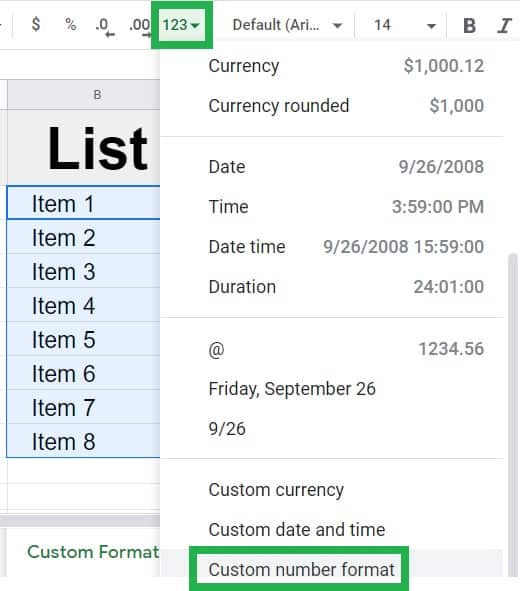
As shown below, the “Custom number formats” menu will open. Here, you can customize the format of your data. In this case, we will indicate that we want three spaces to appear before our text, in other words, we want to indent our text by three spaces.
To do this, in the field titled “Custom number formatting”, type three spaces and then type the symbol @, as shown in the image below (Notice that the @ symbol is offset by three spaces to the right because three space characters were typed before the @ symbol).
Then, click on “Apply”.
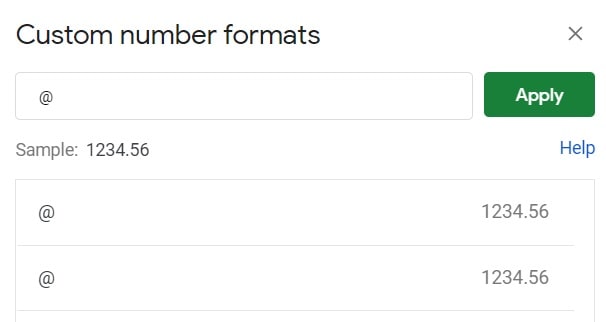
As you can see in the image below, after applying the custom number formatting as described above, the task list items have been indented.
This method is great for indenting text that has already been entered into cells and will also indent newly entered text in the range where you have modified the formatting.
Another interesting thing is that if you click on one of the indented cells, you will see that there are no spaces in the formula bar before the text. Your text/ values entries in the cells remain the same as they were originally, but Google Sheets simply changes the visual formatting.
Customizing the Number of Spaces to Indent
You can choose how much you want to indent your text by varying the number of spaces you enter before the @ symbol in the custom number formatting menu, as described in the example above.
You can indent more by entering more spaces before the @ symbol, or you can indent less by entering fewer spaces before the @ symbol.
You can also use multiple levels of indentation in your sheet, where some cells are indented more than others. Later on, I’ll show you another way to indent with multiple levels.
Indentation Using a Formula
If you prefer, you can also indent text with a formula in Google Sheets. This method adds spaces before your text using a formula, which means one column contains normal text and another column contains text indented by a formula. You can copy and paste the generated list elsewhere by pressing Ctrl + C to copy, then press Ctrl + Shift + V to paste values only, which will transfer only the values and not the formatting or formulas.
To indent with a formula, we will use the ARRAYFORMULA function with the & (ampersand) operator, to instruct Google Sheets to add three spaces before the text in a specified column, like this =ARRAYFORMULA(" "&A2:A).
The above formula combines a string of three spaces with the content of column A. Click here to learn more about using the ARRAYFORMULA function.
Example formula: =ARRAYFORMULA(" "&A2:A)
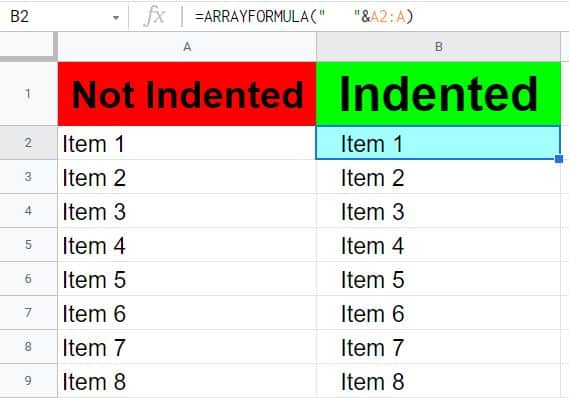
Notice that in the example image above, the text in column A is not indented, but the text in column B is indented by the formula.
Indentation Using Multiple Columns
You can also use additional columns to indent in Google Sheets, where instead of the content of cells being indented within the cell itself, columns are used to create spaces/indentations in your sheet.
As shown below, you can create multi-level lists using multiple columns, for example, where the main item/task is entered in column A and the sub-item/task is entered in column B. This effectively indents the text in column B. See below how to adjust the width of columns for better visual rendering.
If you reduce the width of the first column in the list, as shown below, it makes the indentation less extreme and gives a much nicer appearance to the list. As you can see, since column D is narrow, the sub-items in column E are slightly indented, which gives a nice, organized, and compact look to the list.
This content was originally created by Corey Bustos / SpreadsheetClass.com.
Indenting an Entire Sheet
Do you ever feel like your entire sheet is too far to the left and you need to create some extra space for the entire sheet? A common practice is to add a column to the left of your sheet to indent the entire sheet. This is demonstrated in the example image below. Column A is empty, and the width of the column has been reduced so that the entire sheet is indented.
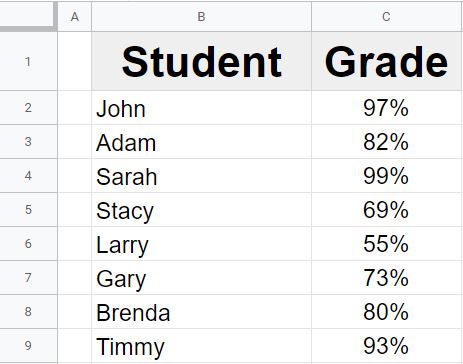
Quickly Indenting Specific Cells
If you want to be able to quickly indent certain cells without having to apply custom formatting every time, you can use “Format Painter” to easily apply the indentation format to the cell(s) you want.
Let’s say we have a list of titles and items under each title, where we want to indent the items in the list but not the titles.
In cell B1, there is a cell with text that already has the custom number formatting applied to automatically indent the text.
Click on the cell that is indented, then click on the “Format Painter” button in the top toolbar (which looks like a paint roller).
Then, click on the cell you want to transfer the formatting to.
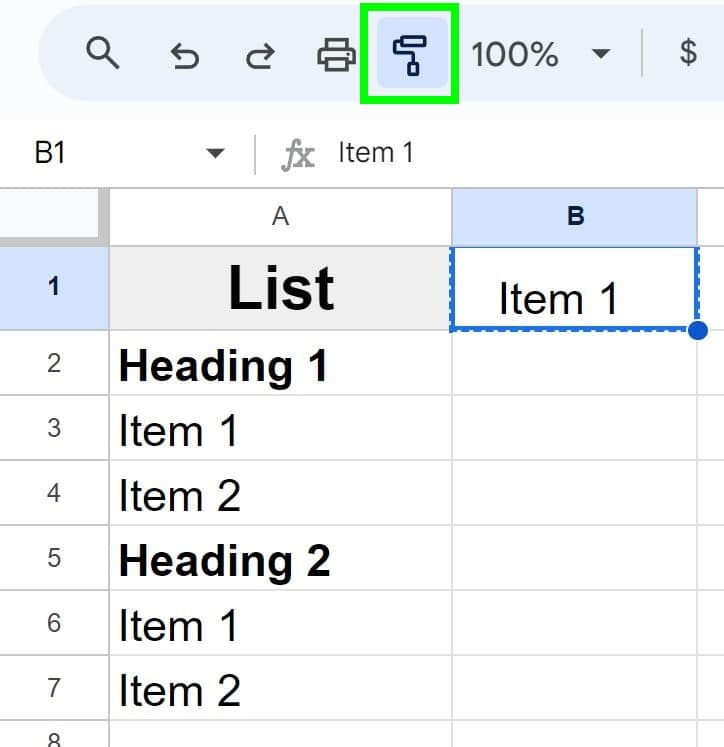
As you can see in the image below, the custom number formatting that indents the cell has now been applied to the list item. Repeat this process with the “Format Painter” function until all the cells you want are indented. If you want, you can apply the formatting to multiple cells at once by selecting a range of cells after clicking the “Format Painter” button.
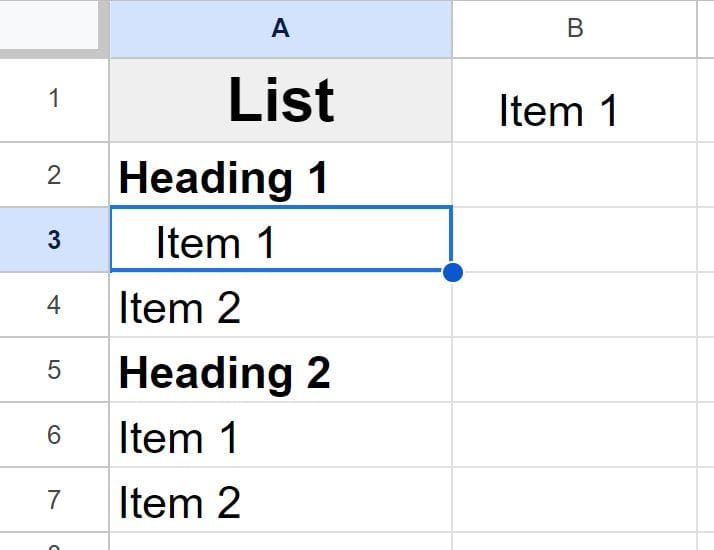
Now you know all the different ways to indent in Google Sheets!
Test Your Knowledge
Answer the following questions about indentation in Google Sheets to test your knowledge! Scroll down to find the answers to the quiz.
Question #1
True or False: Using custom number formatting allows for automatic indentation of text/values.
- True
- False
Question #2
Which functions allow for indenting text?
=ARRAYFORMULA(A2:A)=ARRAYFORMULA(" "&A2:A)=ARRAYFORMULA(B2:B&A2:A)
Question #3
True or False: There is a formula called “INDENT” that allows for text indentation.
- True
- False
Answers to the above questions:
Question 1: True
Question 2: 2
Question 3: False
This article was written for bolamarketing.com. For more tips and tutorials on Google tools, visit Crawlan.com.



